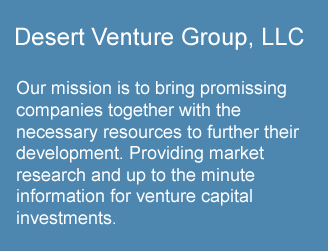






Desert Venture Group, llc is a research firm that provides information for the following areas:
- Early stage companies that are largely past product or technology development risk and can demonstrate some level of actual market validation.
- Early stage companies with exceptional technology or other proprietary advantages that are poised to capitalize on major market trends.
- Later stage middle market buyout opportunities that are attractively priced and offer upside growth potential through strategy modification and management rejuvenation.
We target the following four investment focus areas that we believe offer attractive upside potential and where we have investment experience and market expertise.
Residential and Commercial Development.
Providing investor’s opportunity in secured tax deferred, long and short term returns.
- Long term high yielding debentures (Notes)
- Short term high yielding debentures (Notes)
- Partnership interest in both residential and commercial developments.
Information and Communications
This market encompasses areas that are being transformed by the convergence of high-performance computing, global high-speed telecommunications, and advanced sensing and data analysis. Some example investment areas within Information and communication are as follows:
- Network hardware and software
- Wireless communications
- Distributed computing and interoperable web-based services
- Rich media creation and distribution infrastructure
We focus on areas within sciences that can capitalize on major market demographic trends. Some example investment areas are as follows:
- Medical devices
- Diagnostics and Imaging technology
- Specialty pharmaceuticals
We look for service businesses that are well positioned to capitalize on outsourcing trends and efficiencies being created by rapid advances in IT and telecommunications technologies. Example investment areas are as follows:
Residual Reoccurring Income
These revenues are recurring and are derived from the fees paid by merchants/small businesses each time they accept an electronic form of payment for their goods or services. For example: A merchant pays on average 2.5% ($2.50 for every $100 processed) on each Visa or MasterCard transaction they accept. DVG earns approximately .40% ($.40 for every $100 processed) as revenue. Merchants sign a three year agreement to process with a recurring automatic renewal. Each contract has a cancellation penalty for early termination.
Value is created in this industry by acquiring merchant customers for a cost that is lower than the price the portfolio of customers can be sold for in the marketplace. The marketplace for acquisition of established residual portfolios is between 3-4 times annual net revenue or 6-12 time EBITDA. Standard methods used by small and medium size ISO’s to acquire customers and build portfolios rely on agent networks or some kind of affinity relationship. These methods are generally labor intensive and require extensive sharing of the portfolio’s residual stream with the labor involved in generating the portfolio.
DVG uses a customer acquisition process that is not labor intensive. Instead it utilizes direct mail and telemarketing to contact new businesses started across the US. This specific method of customer acquisition was developed by Ryan Bridges over the last five years. During the last year Desert Venture Group has invested in a sequence of test marketing efforts to further refine the method and the menu of merchant services offered through this method. We estimate that this method requires a customer acquisition cost of roughly one third the value of that customer in the acquisition market for portfolios of residuals.
In addition, overall operating efficiencies can be gained through economies of scale and there is significant benefit to ramping up to capacity as quickly as possible. These efficiencies come in the form of reduced COGS, marketing costs, and overhead contribution. Simultaneously, DVG’s total enterprise value is increased by more rapid growth and a larger total portfolio.
What We Look For In a Company:
A Large Market Opportunity
We look for companies with a market opportunity that is large enough to provide ample room for growth over several years. In addition, we are particularly attracted to companies that have positioned their products or services to capitalize on major structural changes within their target markets.
Sustainable Competitive Advantage
A company must be able to articulate a simple, clear business plan that explains why it will be a winner and how it can sustain a winning position over an extended period of time. We look for sources of competitive advantage based on unique market position, a novel competitive strategy, specialized expertise, patents, trade secrets, or similar.
Stellar Management
We believe strongly that even a great idea has little value unless there is a great management team to turn it into reality. We look for experienced management that has domain expertise in the company’s business area, a track record of prior success and the drive and passion needed to overcome the many inevitable obstacles on the road to success.
An Attractive Financial Model
We expect a company’s management to provide an attractive but realistic financial model that shows how it will make money, how much capital it will need, and how value will be created for investors. We look for businesses that can deliver strong margins, have low to medium capital intensity, and a high degree of financial and operational scalability.
High Exit Potential
In evaluating any investment, we carefully consider the available avenues for the company to achieve a successful exit. We are attracted to investment areas where strong valuations exist for comparable public and private companies. We also look at the history of ROI activity in the specific investment area and the number and quality of potential acquirers. Finally, we also prefer to see that a company is addressing a large enough market opportunity to make a future IPO a meaningful possibility.








